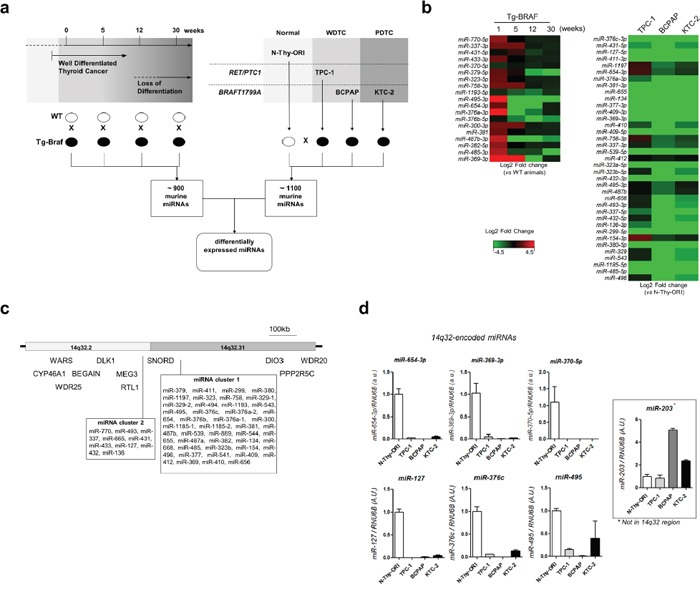Down-regulation of 14q32-encoded miRNAs and tumor suppressor role for miR-654-3p in papillary thyroid cancer.
Papillary thyroid carcinoma (PTC) is the most prevalent malignant neoplasia of the thyroid gland. A fraction of PTC cases show loss of differentiation and aggressive behavior, with radioiodine therapy resistance and metastasis. Although microRNAs (miRNAs) emerged as promising molecular markers for PTC, their role in the loss of differentiation observed during PTC progression remains to be fully understood. We performed the large-scale analysis of miRNA expression during PTC progression in BRAFT1799A-transgenic animals (Tg-Braf) and thyroid cancer cell lines and identified the marked downregulation of several miRNAs from the region 14q32. Data from The Cancer Genome Atlas (TCGA) confirmed the global downregulation of miRNAs from the 14q32 region in human PTC. The regulatory network potentially suppressed by these miRNAs suggests that key cancer-related biological processes such as cell proliferation, adhesion, migration and angiogenesis. Among the downregulated miRNAs, we observed that miR-654-3p levels decrease with long-term PTC progression in Tg-Braf mice and inversely correlate with EMT. The in vitro restoration of miR-654-3p decreased cell proliferation and migration and induced reprogramming of metastasis-related genes, suggesting a tumor suppressor role for this miRNA. In conclusion, we show global downregulation of 14q32-encoded miRNAs in an in vivo model of PTC progression. The potential circuitry in which these miRNAs are involved suggests that these miRNAs could play a key role in the pathophysiology of PTC and therefore be relevant for the development of new therapeutic strategies.
Authors
Murilo Vieira Geraldo; Helder Imoto Nakaya; Edna Teruko Kimura
External link
Publication Year
Publication Journal
Associeted Project
Integrative Biology
Lista de serviços
-
As antisense RNA gets intronic.As antisense RNA gets intronic.
-
Androgen responsive intronic non-coding RNAs.Androgen responsive intronic non-coding RNAs.
-
Conserved tissue expression signatures of intronic noncoding RNAs transcribed from human and mouse loci.Conserved tissue expression signatures of intronic noncoding RNAs transcribed from human and mouse loci.
-
The intronic long noncoding RNA ANRASSF1 recruits PRC2 to the RASSF1A promoter, reducing the expression of RASSF1A and increasing cell proliferation.The intronic long noncoding RNA ANRASSF1 recruits PRC2 to the RASSF1A promoter, reducing the expression of RASSF1A and increasing cell proliferation.
-
Antisense intronic non-coding RNA levels correlate to the degree of tumor differentiation in prostate cancer.Antisense intronic non-coding RNA levels correlate to the degree of tumor differentiation in prostate cancer.
-
Insight Into the Long Noncoding RNA and mRNA Coexpression Profile in the Human Blood Transcriptome Upon Leishmania infantum Infection.Insight Into the Long Noncoding RNA and mRNA Coexpression Profile in the Human Blood Transcriptome Upon Leishmania infantum Infection.
-
Long non-coding RNAs associated with infection and vaccine-induced immunityLong non-coding RNAs associated with infection and vaccine-induced immunity
-
Comparative transcriptomic analysis of long noncoding RNAs in Leishmania-infected human macrophagesComparative transcriptomic analysis of long noncoding RNAs in Leishmania-infected human macrophages
-
SARS-CoV-2 Selectively Induces the Expression of Unproductive Splicing Isoforms of Interferon, Class I MHC, and Splicing Machinery Genes.SARS-CoV-2 Selectively Induces the Expression of Unproductive Splicing Isoforms of Interferon, Class I MHC, and Splicing Machinery Genes.

